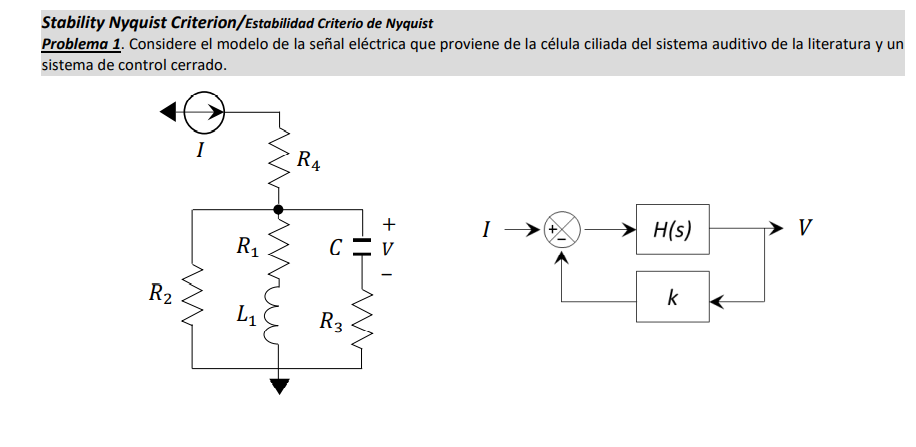Pregunta: Stability Nyquist Criterion/Estabilidad Criterio de Nyquist Problema 1. Considere el modelo de la señal eléctrica que proviene de la célula ciliada del sistema auditivo de la literatura y ur sistema de control cerrado.a. Obtain and write down the Transfer function H(s)=V(s)/I(s) (Try to simplify the equation by joining parameters together and naming them,
I already have the answer to a and b, need c and d preferably.
- Esta pregunta aún no se resolvió!¿No es lo que buscas?Envía tu pregunta a un experto en la materia.Texto de la transcripción de la imagen:Stability Nyquist Criterion/Estabilidad Criterio de Nyquist Problema 1. Considere el modelo de la señal eléctrica que proviene de la célula ciliada del sistema auditivo de la literatura y ur sistema de control cerrado. a. Obtain and write down the Transfer function H(s)=V(s)/I(s) (Try to simplify the equation by joining parameters together and naming them, e.g., A, B, C, ..., Z). Compare and confirm the transfer function by showing the plots of LTSpice and Simulink. Use the same time of simulation. Set R1=2Ω,R2=100Ω,R3=50 mΩ,R4=100Ω,L1=10mH,C= 200uF and I=1 A. (15 puntos) b. Obtain the time dependent response of H(s) in Simulink. Set R1=2Ω,R2=100Ω,R3=50 mΩ,R4=100Ω, L 10mH,C=200uF and I=1 A. Use a signal generator in Simulink and select a square waveform as an input with amplitude I and frequency of 100rad/sec. Show the plot by changing the time of simulation to 0.2 seconds. Use the next model as a guide. (10 puntos) c. Obtain and write down the state-space equation and block diagram using state-space analysis. (15 puntos) d. Obtain and write down the transfer function V(s)/ /I(s) of the closed-loop control system depicted above and obtain and write down the loop transfer function HL(s). (5 puntos) e. Using the Nyquist criterion, obtain HL (jw) (10 puntos) f. Obtain wIm=0 of the system by forcing the imaginary part of HL (jw) to zero. Set R1=0.1Ω,R2=1Ω,R3=1Ω,R4= 100Ω,L1=2H,C=1 F, and gain of 1 . (10 puntos) g. Using WIm=0, evaluate HI.(WIm=0) and write down the solution in the form of R+jX. Use gain k of 1 . Is the system stable? Explain your answer by comparing the point of stability and your results. (15 puntos) h. Verify the stability of the system by plotting HL (jw) for angular frequencies from 0 to 1000rad/sec, and gains k [1 10 1001000 ]. Set R1=0.1Ω,R2=1Ω,R3=1Ω,R4=100Ω,L1=2H,C=1 F. Show the plot of imaginary vs. real. For presenting your results, set the y limit to ([−0.50.5]) and the x limit to ([-1.1 1 ]). (10 puntos) i. Mention the applications of this model of the auditory system in the biomedical area. Mention the applications of the Nyquist criterion when applying it in physiological models in the biomedical area. (10 puntos)
Texto de la transcripción de la imagen:
Stability Nyquist Criterion/Estabilidad Criterio de Nyquist Problema 1. Considere el modelo de la señal eléctrica que proviene de la célula ciliada del sistema auditivo de la literatura y ur sistema de control cerrado.
a. Obtain and write down the Transfer function H(s)=V(s)/I(s) (Try to simplify the equation by joining parameters together and naming them, e.g., A, B, C, ..., Z). Compare and confirm the transfer function by showing the plots of LTSpice and Simulink. Use the same time of simulation. Set R1=2Ω,R2=100Ω,R3=50 mΩ,R4=100Ω,L1=10mH,C= 200uF and I=1 A. (15 puntos) b. Obtain the time dependent response of H(s) in Simulink. Set R1=2Ω,R2=100Ω,R3=50 mΩ,R4=100Ω, L 10mH,C=200uF and I=1 A. Use a signal generator in Simulink and select a square waveform as an input with amplitude I and frequency of 100rad/sec. Show the plot by changing the time of simulation to 0.2 seconds. Use the next model as a guide. (10 puntos) c. Obtain and write down the state-space equation and block diagram using state-space analysis. (15 puntos) d. Obtain and write down the transfer function V(s)/ /I(s) of the closed-loop control system depicted above and obtain and write down the loop transfer function HL(s). (5 puntos) e. Using the Nyquist criterion, obtain HL (jw) (10 puntos) f. Obtain wIm=0 of the system by forcing the imaginary part of HL (jw) to zero. Set R1=0.1Ω,R2=1Ω,R3=1Ω,R4= 100Ω,L1=2H,C=1 F, and gain of 1 . (10 puntos) g. Using WIm=0, evaluate HI.(WIm=0) and write down the solution in the form of R+jX. Use gain k of 1 . Is the system stable? Explain your answer by comparing the point of stability and your results. (15 puntos) h. Verify the stability of the system by plotting HL (jw) for angular frequencies from 0 to 1000rad/sec, and gains k [1 10 1001000 ]. Set R1=0.1Ω,R2=1Ω,R3=1Ω,R4=100Ω,L1=2H,C=1 F. Show the plot of imaginary vs. real. For presenting your results, set the y limit to ([−0.50.5]) and the x limit to ([-1.1 1 ]). (10 puntos) i. Mention the applications of this model of the auditory system in the biomedical area. Mention the applications of the Nyquist criterion when applying it in physiological models in the biomedical area. (10 puntos)

Estudia mejor, ¡ahora en español!
Entiende todos los problemas con explicaciones al instante y pasos fáciles de aprender de la mano de expertos reales.
